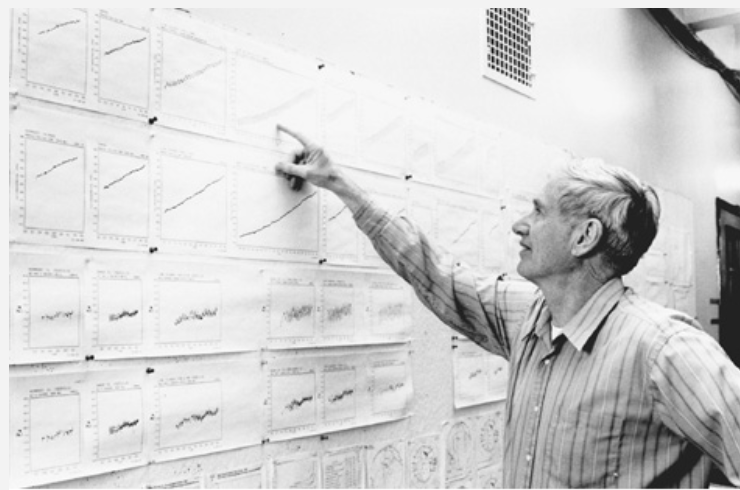In 1955 in the wilds of Big Sur, a young Caltech researcher named Charles David Keeling gathered carbon dioxide samples among Northern California’s towering redwoods. Crawling out of his sleeping bag several times a night on research trips conducted over the course of 18 months, from January 1955 to June 1956, Keeling measured background levels of carbon dioxide across the western United States — at Big Sur, but also at desert and high mountain stations, in forests and grassland, above the city of Los Angeles, and over the waters of the Pacific Ocean.
Keeling’s findings would lead him to conduct a separate series of experiments from the top of the Hawaiian volcano Mauna Loa resulting in the famous Keeling Curve — a visual depiction of rising atmospheric carbon dioxide (CO2) caused by the burning of fossil fuels. His work underpins our understanding of manmade climate change.

Unknown until now, however, is the fact that Keeling’s earliest research into carbon dioxide across the western U.S. was funded in part by the fossil fuel industry via a private foundation — and that in 1954 this foundation was informed of the potential impact of manmade carbon dioxide emissions on both the climate and human civilization.
Newly discovered documents affirm that the automobile and petroleum industries funded early climate science Keeling conducted at the California Institute of Technology (Caltech) between 1954 and 1956. Records show that “oil and auto companies” sponsored the scientist’s research via an organization called the Southern California Air Pollution Foundation, formed in 1953 to tackle Los Angeles’s infamous smog. American Motors, Chrysler, Ford, and General Motors were among 18 automotive companies that gave money to the foundation.

A 1959 internal U.S. Public Health Service memo also identifies the American Petroleum Institute (API) and the Western Oil & Gas Association — the oldest petroleum trade association in the U.S., which is now known as the Western States Petroleum Association — as “major contributors to the funds of the Air Pollution Foundation.” Its Board of Trustees included top-level representatives from the Southern California Gas Company, the Southern California Edison Co., Chrysler, General Motors, and Union Oil (now Chevron). And from mid-1955, these trustees were also appraised of research projects by a seven-man “technical advisory committee,” which included a senior official from API as well as scientists from the Richfield Oil Corporation (now BP) and Chrysler.
With the discovery of these Air Pollution Foundation documents, it is now possible to date the earliest sponsorship of climate science by the fossil fuel industry to 1954, approximately a quarter of a century before Exxon’s internal research program of the late 1970s. These new documents provide important evidence that the fossil fuel industry has been intricately connected to climate science from its earliest beginnings — not only as a driver of the greenhouse effect behind climate change, but also as a contributor to the scientific discoveries that would transform our understanding of humanity’s relationship with the Earth and its atmosphere.
It’s important to know that the oil industry sponsored climate science research in the 1950s because it reveals a picture of a much more nuanced, closely connected world of science and the frontiers of scientific discovery than the oil industry has admitted to.
In addition, despite being warned about the potential climate impacts of CO2 in 1954, 35 years later numerous members and sponsors of the Air Pollution Foundation (including API, the Automobile Manufacturers Association, Chevron, and BP) participated in a multi-million dollar campaign attacking climate policies aimed at tackling global warming and promoting denial of the science they themselves had helped to fund.
Previously unseen correspondence between Caltech and the Air Pollution Foundation shows that the potential climate impact of fossil-fuel-generated CO2 emissions was communicated to the foundation in November 1954. Caltech’s research proposal, sent to the foundation by Keeling’s research director, Samuel Epstein, emphasized both the potential impact on Earth’s climate of burning “coal and petroleum,” and the prospect of using newly developed carbon isotope analysis at Caltech to identify “changes in the atmosphere.”
The “possible consequences of a changing concentration of the CO2 in the atmosphere with reference to climate … may ultimately prove of considerable significance to civilization,” Epstein wrote.
Want to be the first to know about investigations like this? Sign up for our newsletter!
By December 1954, the Air Pollution Foundation had approved an allocation of $13,814 (approximately $158,000 in today’s money) to fund Keeling’s earliest CO2 investigations.
These never-before-seen documents from the Caltech Archives and the U.S. National Archives, along with material from the Charles David Keeling papers at the University of California, San Diego, and local Los Angeles newspapers from the 1950s, establish the Air Pollution Foundation’s sponsorship of Keeling’s research at Caltech as the earliest-known instance of climate science funded by the fossil fuel industry. It’s possible it was also the first time that the oil industry was directly informed about CO2-induced climate change — five years before physicist Edward Teller warned the API of the disruptive consequences of burning fossil fuels.
Fossil Fuel Fingerprints
Carbon atoms contain a combination of the isotopes carbon-12 (C12), carbon-13 (C13), and carbon-14 (C14). Carbon atoms from fossil fuels, however, contain relatively little C13 and almost no C14, which is radioactive and decays over time.
In the 1940s and early 1950s, a carbon isotope scientific revolution was underway in the United States. Scientists had learned that they could measure the different ratios of carbon isotopes in materials to accurately determine the age of ancient objects: carbon dating. By analyzing the isotopic fingerprint of carbon atoms in tree rings, scientists could also identify whether the carbon dioxide absorbed by trees through photosynthesis had been produced naturally or as a result of burning fossil fuels. And, by measuring the isotopic ratios in tree rings of various ages, researchers could also estimate how far CO2 concentrations had risen since the Industrial Revolution as a result of burning fossil fuels.
In a proposal sent to the Air Pollution Foundation in November 1954, Keeling’s research director Epstein wrote, “It is clear that several factors contribute to the variations in the isotopic composition of carbon in trees.” Among these factors, Epstein explained, were the various ecological conditions under which the tree grew, including the isotopic composition of the carbon in the atmosphere. “Since 1840, the carbon-isotope ratio (C12/C13) has increased in the trees so far investigated,” he continued — an increase which could be explained by a change in the carbon-isotope ratio in atmospheric carbon dioxide “resulting from the burning of the C12-enriched coal and petroleum.”

Epstein’s research proposal for the Air Pollution Foundation left no doubt about the potential significance of this research. Approximately sixty years before the Paris Agreement, he described the “concentration of CO2 in the atmosphere” as a matter “of well recognized importance to our civilization” and explained that the possible consequences of “a changing concentration of the CO2 in the atmosphere with reference to climate” may “ultimately prove of considerable significance to civilization.”

His proposal also detailed how the Air Pollution Foundation’s money would be spent. “A thorough investigation of the distribution of the isotopes of carbon in the atmosphere” would be conducted via the comparison of atmospheric samples gathered “over the ocean, over mountain areas, and from industrial localities similar to the Los Angeles Basin.” Such a study would be “important to geochemistry and should be relevant to the smog problem,” he wrote, referring to the foundation’s stated mission of tackling smog. This reference alluded to the possibility that isotope analysis might reveal the source of Los Angeles’s smog by identifying carbon ratios attributable either to the burning of fossil fuels, such as automobile exhaust, or to other sources, such as backyard garbage fires.
The Air Pollution Foundation had been established to tackle smog. However, Epstein cautioned that a “contribution to the solution of the smog problem” from Caltech’s proposed research was “not assured at present.” Nothing in the historical record suggests that the foundation was interested in funding CO2 research for its own sake. But Epstein’s caution, paired with his comments on the potential impact of CO2 on the climate and our civilization demonstrates that the foundation knowingly approved funding for Caltech’s CO2 studies on the understanding that the research might contribute to addressing the smog problem — and also potentially had significance that went beyond local air pollution.
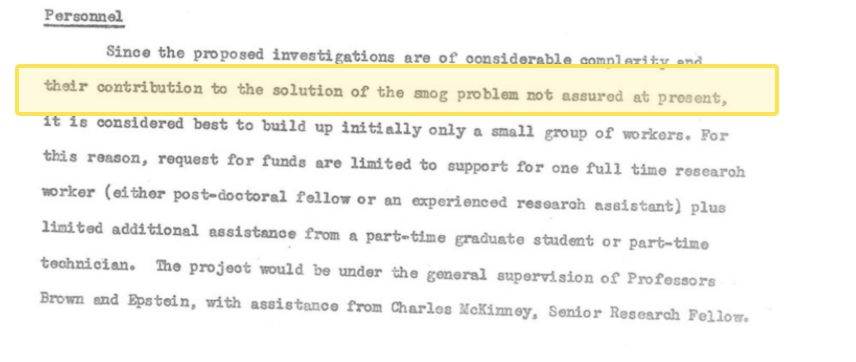
A foundation press release, “Background for Twelve-Month Research Program” dated November 16, 1954, also suggests that this distinction was clear to its members. Itemized under the category of “Fundamental Research in Physics, Meteorology and Chemistry” — separate from other purely smog-related research — is an entry for “Study of Carbon Isotopes: In LA Atmosphere $5,000” and also “In General $10,000.”
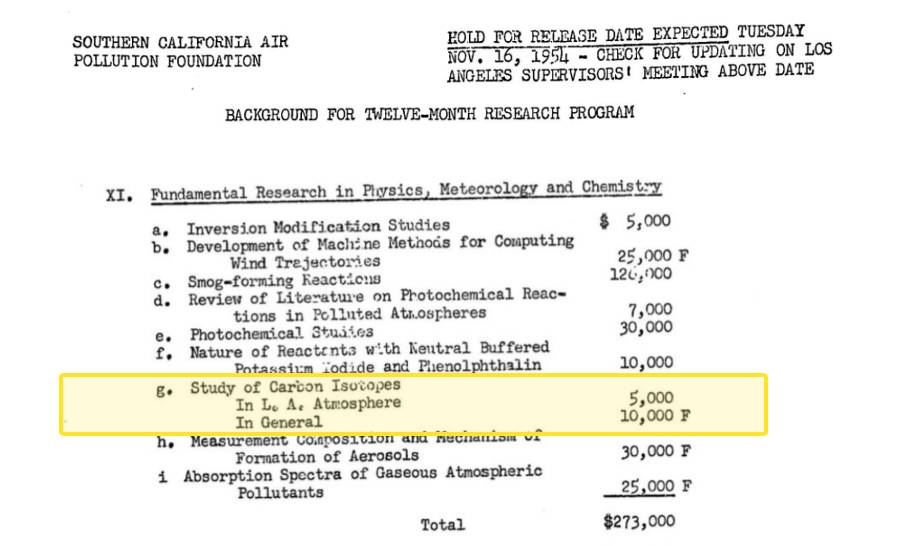
Due to the complexity of the investigations and the lack of guaranteed results, Epstein suggested the request for funds be limited to support one full time research worker” — Keeling.
Documents show that on December 1, 1954, the Air Pollution Foundation signed an agreement with Caltech approving Epstein’s budget request of $13,814 for the isotope study. A month later Keeling would begin his program of CO2 sampling, starting in California’s desert.
Air Pollution Foundation
Established by the city’s businessmen, industrialists, and civic leaders in November 1953 to tackle Los Angeles’s “smog problem,” the Southern California Air Pollution Foundation’s financing details were not initially made public. However, between November 1954 and May 1955, various local newspapers disclosed that “oil and auto companies” along with banks, the aircraft industry, and even department stores had all contributed “to the Air Pollution Foundation’s $1,250,000 fund for smog research.” Supplementing these private donations, the Los Angeles Times also related that the foundation sought public funding from federal, state, and county sources, while a May 1955 “Statement of Policy” from the foundation announced that “trade associations” were also among its 150 donors.
The foundation had obvious ties to local fossil fuel interests. Among its founding trustees were the president of Union Oil (Chevron) and the president of the Southern California Gas Company (SOCAL). Additional trustees included top executives of the Southern California Edison Co, Western Airlines, North American Aviation, Southern Pacific Railroad, Western Consolidated Steel, and Chrysler, as well as the director of General Motors’ research laboratories, the famous Charles F. Kettering. University presidents (including Caltech’s), the president of the Los Angeles Chamber of Commerce, the studio head of Paramount Pictures, and a future director of the C.I.A. were among the other influential trustees.
According to the 1955 Statement of Policy, the Air Pollution Foundation’s managing director and staff of experts conducted its day-to-day activities under “the general supervision of the Board of Trustees.” The policy statement explained that the principal reason for the trustees’ membership on the Board was to make certain that they would be party “to all facts and evidence brought to light on the problem” so that they “and their colleagues in like enterprises” might work toward a solution.
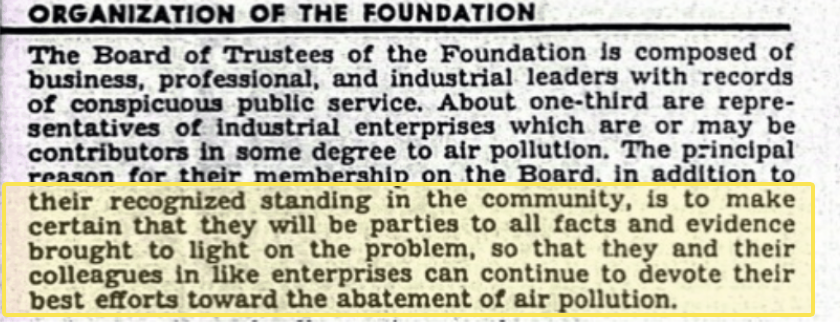
Approximately one-third of the trustees came from industries “which are or may be contributors in some degree to air pollution,” the statement explained. It fully outlined the trustees’ responsibilities, expanding on the above statement: “The principal reason for their membership on the Board, in addition to their recognized standing in the community, is to make certain that they will be parties to all facts and evidence brought to light on the problem so that they and their colleagues in like enterprises can continue to devote their best efforts toward the abatement of air pollution.”
It is not known at this time how closely individual trustees read the reports shared with them. However, if they were carrying out their duties faithfully, they would have been acquainted with “all facts and evidence brought to light on the problem.”
While the trustees did not contribute personally to the foundation, some represented “companies or organizations” that provided “financial support.”
The foundation’s full financial details do not seem to have been published. However, some specifics are available. For instance, records show that between 1954 and 1956, the automobile industry gave at least $280,000 (equivalent to $3.3 million today) to the Air Pollution Foundation. Eighteen automotive companies were listed as having contributed to this total, including the so-called “Big Three”: Chrysler, Ford, and General Motors. More specifically, the Los Angeles Times reported that the foundation received $50,000 from the Automobile Manufacturers’ Association (an automobile industry trade group) and $5,000 from the Ford Motor Co. in June 1954; and a further $72,500 from the Automobile Manufacturers Association and $27,500 from Ford in April 1955.
The Air Pollution Foundation also had close ties with the oil industry, particularly the American Petroleum Institute (API). An Air Pollution Foundation newsletter described the creation in August 1955 of a “technical advisory committee of seven men with broad scientific experience and knowledge in air pollution to advise its Board of Trustees on research projects.” According to the newsletter, this high-level committee met regularly and its members included top engineers and scientists of “the auto industry” and “the oil industry.” Contemporary newspaper sources reveal that one of these seven men was executive secretary of the API’s Smoke & Fumes Committee, William A. Claussen, and that two others came from the Richfield Oil Corp. (now BP) and Chrysler.

Although precise details of the API’s financial support for the Air Pollution Foundation are not yet available, a 1959 U.S. Public Health Service document stated that “The American Petroleum Institute and the Western Oil & Gas Association have been major contributors to the funds of the Air Pollution Foundation.” It’s not clear from this document exactly when the API and the Western Oil & Gas Association (now called the Western States Petroleum Association) began funding the Air Pollution Foundation. However, Claussen’s appointment to the foundation’s technical advisory committee on August 10, 1955, suggests that API funding may have begun by this date. The American Petroleum Institute did not respond to questions about its support of and involvement with the Air Pollution Foundation.
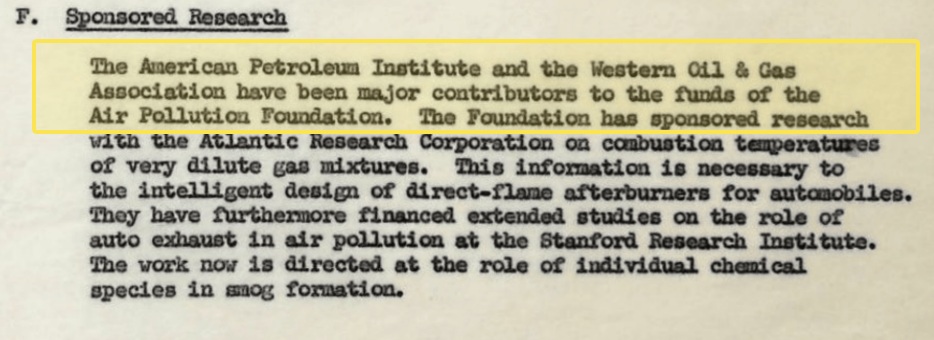
Another senior figure at the Air Pollution Foundation, its vice president and chief engineer W. L. Faith, also had links to the API. In addition to his role at the Air Pollution Foundation, Faith was simultaneously a member of the Coordinating Research Council, a joint research venture controlled by the American Petroleum Institute and the Society of Automotive Engineers. By 1956 Faith would become the Air Pollution Foundation’s overall managing director.
On June 28, 1955, Faith authored an internal memo sent to the Research Committee of the Air Pollution Foundation’s Board of Trustees containing details of the foundation’s proposed “Research Program for 1956.” A “Special Category” listed “Continuation of carbon isotope studies … currently being carried out at Caltech with APF funds.”
Historian Benjamin Franta has shown in 2022’s “Big Carbon’s Strategic Response to Global Warming, 1950-2020” that in 1955 the API also funded research, code named “Project 53,” at Keeling and Epstein’s Caltech lab under the overall guidance of Epstein’s boss, Professor Harrison Brown. Brown’s proposal to the API explained that fossil fuels were causing atmospheric CO2 levels to rise but did not mention the possible climate impacts of this rise. Nevertheless, as Franta also demonstrates, the potential global warming effect of this increasing atmospheric CO2 could be inferred from already established science. Documents discovered by Franta show that the API-sponsored research primarily focused on other things but included work on CO2 in tree rings. While Caltech’s researchers informed the API that they were using their equipment to make around 2,300 CO2 tree ring measurements per year, the API does not appear to have published the results.
What’s certain is that in December 1955, the Air Pollution Foundation approved a one-year extension of its sponsorship of Keeling’s work — a decision likely overseen by Faith as well as the API’s Claussen and the other members of the foundation’s technical advisory committee, according to their appointed role as advisors to the Board of Trustees’ research projects.
Afternoon Surprise
Almost a year later, in the fall of 1956, Samuel Epstein sent the Air Pollution Foundation an informal research update prepared by Keeling titled, “The Variation in the Concentration and Isotopic Composition of Atmospheric Carbon Dioxide.” Epstein told the Air Pollution Foundation that, having used its grant to support Keeling’s research, it had been possible to establish the “concentration and isotopic composition of CO2 in different types of localities.”
Epstein’s papers at the Caltech Archives do not contain a copy of Keeling’s report. However, the Charles D. Keeling papers, held at the University of California, San Diego, contain a paper by Keeling from the same year, 1956, with an almost identical title, “The Concentration and Isotopic Composition of Atmospheric Carbon Dioxide.” This paper contains the data Keeling compiled using the Air Pollution Foundation’s grant, and shows his findings of consistently similar average carbon dioxide levels at varying locations across the United States and above tropical waters.
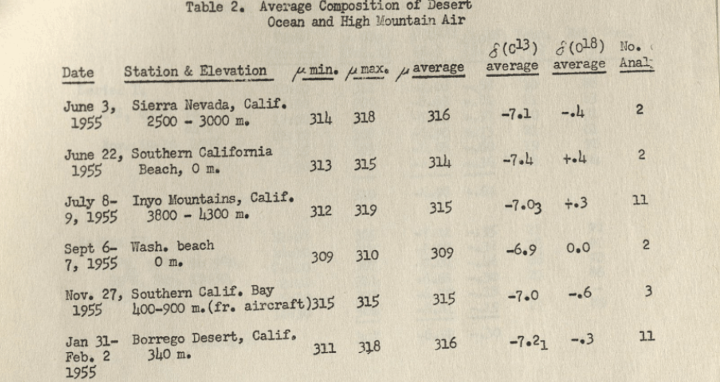
Keeling’s later writings in the Annual Review of Energy and the Environment (1998) describe his surprise at finding that everywhere he went, the “afternoon air” seemed “always to have nearly the same amount of CO2, about 310 parts per million (ppm).” Based on existing scientific literature, Keeling had expected daytime concentrations to vary. Instead, he found that a concentration of 310 ppm of CO2 seemed to prevail over large regions of the northern hemisphere. In addition to this, Keeling noted that the carbon isotopic ratios in the afternoon were also “all about the same.” If CO2 concentrations were similar across the globe, it would be possible, using continuous measurements over an extended time period, to estimate how much CO2 produced by burning fossil fuels was being absorbed by natural carbon sinks (forests, oceans) and how much was being emitted into the earth’s atmosphere.
Keeling’s 1956 paper emphasized the wider significance of his work in predicting this atmospheric impact of burning fossil fuels. He wrote, “The factors which control the concentration and isotopic composition of carbon dioxide in the earth’s atmosphere have been studied with the view of predicting the effect of terrestrial plants, of surface ocean water, and of the burning of coal and petroleum on atmospheric carbon dioxide.”
Ahead of the Keeling Curve
Confident in the accuracy of his measurements, Keeling communicated his findings to an employee of the U.S. Weather Bureau and, in the summer of 1956, its director of meteorological research, Harry Wexler, invited him to Washington, D.C., to present his data. Impressed, Wexler suggested that the young researcher continue his investigations by measuring CO2 at the newly built observatory on the Hawaiian volcano Mauna Loa. Keeling secured federal sponsorship for this work and measured atmospheric CO2 on Mauna Loa, observing a rising trend of CO2 increasing year on year from approximately 313 ppm in 1957 to 320 ppm in 1967. Caused primarily by the burning of fossil fuels, the depiction of this trend would come to be known as the Keeling Curve — a key piece of evidence that climate change is human caused.
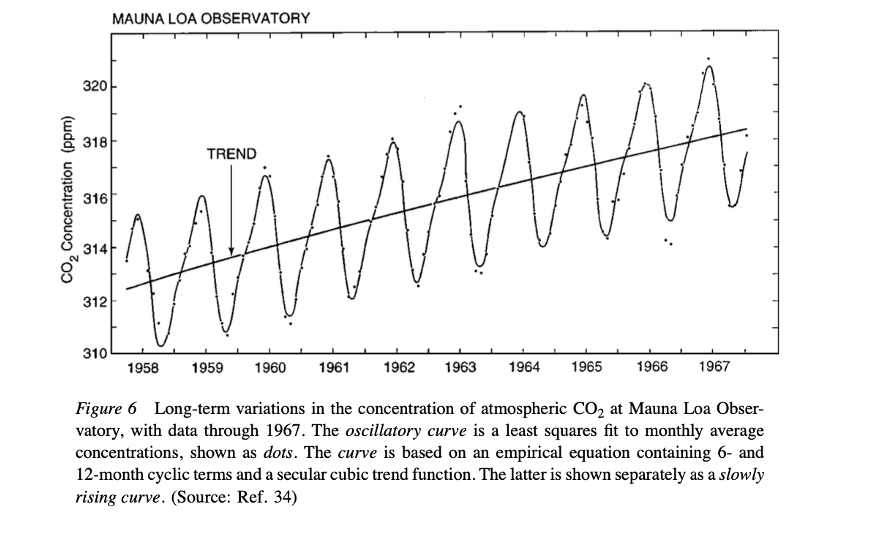
Keeling’s summer 1956 trip to D.C. came shortly before the Caltech project’s end; in October 1956, the university’s carbon dioxide investigations for the Air Pollution Foundation concluded. Epstein’s letter to the foundation’s senior physicist, Nicholas Renzetti, declared that while using the isotopic ratio of carbon dioxide as an “index to the relative contribution of industrial activity” to the atmosphere “may be worth while pursuing in more detail,” it was felt “that such a survey could not be done here at present.” Epstein informed Renzetti that Keeling was preparing a detailed paper for publication and that a copy would be forwarded as a final report on this research. He also asked permission to spend the remaining $9,000 of the APF’s grant on constructing equipment more pertinent to analyzing the Los Angeles atmosphere.
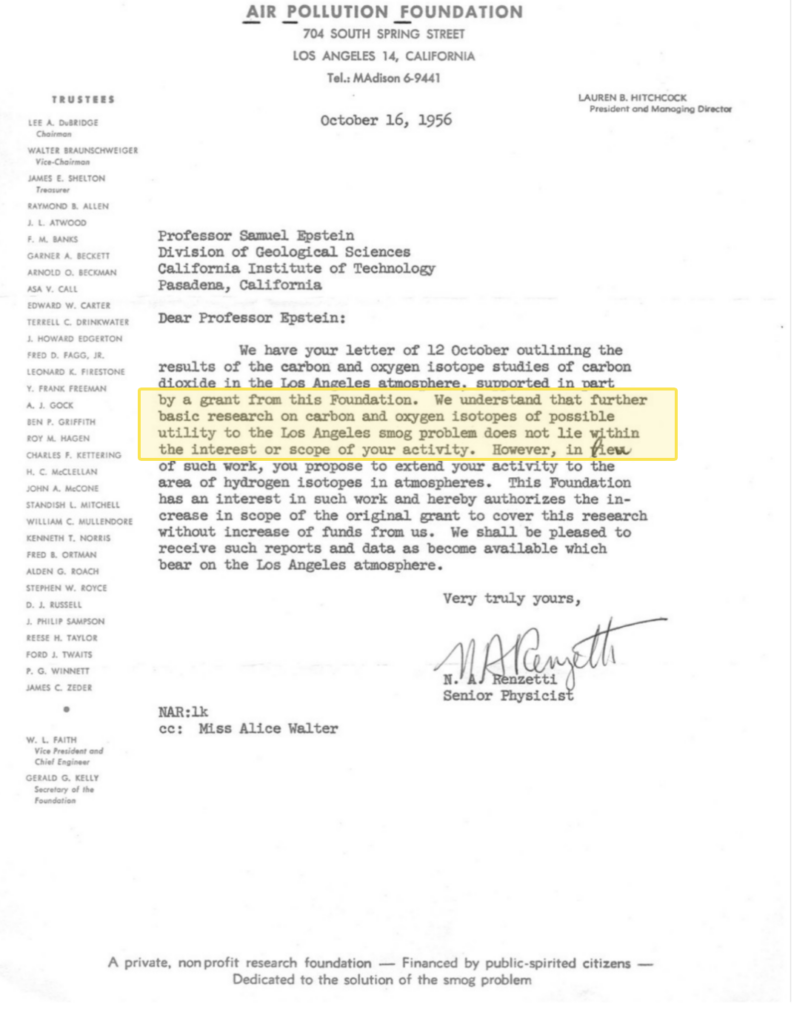
Epstein did not elaborate on why further research could not be conducted at Caltech. By the fall of 1956 Keeling had moved from Caltech to the Scripps Institute of Oceanography where he would pursue his work on CO2 under Scripps’ Director and climate scientist, Roger Revelle. Keeling’s departure may have played a part in Caltech’s stated decision not to pursue further investigations into the contribution of fossil fuels to atmospheric CO2 levels. In any case, the Air Pollution Foundation’s main aim was to sponsor research directly related to solving local air pollution problems rather than fundamental research into CO2 despite the “significance to civilization” it posed. What is clear however is that the foundation — including its members with links to the fossil fuel industry — was informed of the potential to identify the contribution of fossil fuel emissions to atmospheric CO2 levels. The foundation chose not to pursue this research further.
Read Parts 2 and 3 of our investigation to learn about the forgotten conference that sparked climate concern and brought the CO2-climate link to the attention of a U.S. President for the first time.
Responding to Epstein on October 16, 1956, Renzetti expressed the foundation’s understanding that further research on carbon isotopes “of possible utility to the Los Angeles smog problem” did not “lie within the interest or scope” of Caltech’s activity. Instead, Renzetti accepted Epstein’s proposal to use the remaining funds for Caltech’s work on hydrogen isotopes that might “bear on the Los Angeles atmosphere.”
The Air Pollution Foundation’s 1956 response to Keeling’s carbon isotope research foreshadowed Exxon’s response in the 1980s to its own in-house scientists seeking to explore “past and future growth of atmospheric CO2 emissions.” As revealed by Inside Climate News, in the late 1970s Exxon scientists suggested a program of research that would “help evaluate the so-called ‘greenhouse effect.’” Some of this in-house work proposed investigating the isotopes of vintage wine to see whether the blame for rising CO2 levels could be placed on deforestation rather than fossil fuel emissions. These isotope studies, however, appear to never have started, falling victim to Exxon’s 1982 cuts to its CO2 research once it became clear that fossil fuels were indeed the leading cause of CO2 emissions.
In 1962, a few years before the now-famous curve, Keeling would be asked to present his work at a forthcoming conference on the “Carbon Dioxide Content of the Atmosphere” sponsored by the Conservation Foundation. This philanthropic conservation group was partly funded for 1962, the year in which the conference was organized, by Standard Oil of New Jersey (now ExxonMobil), Standard Oil of California (Chevron), and Richfield Oil (BP). This long-overlooked event would help transform awareness of the carbon dioxide problem from a relatively unknown area of pure scientific inquiry to a matter of pressing national and international urgency, ultimately bringing the issue to the attention of one of the most powerful men in the world.
Subscribe to our newsletter
Stay up to date with DeSmog news and alerts


